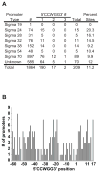Conservation of Dcm-mediated cytosine DNA methylation in Escherichia coli
- PMID: 22150247
- PMCID: PMC3976566
- DOI: 10.1111/j.1574-6968.2011.02482.x
Conservation of Dcm-mediated cytosine DNA methylation in Escherichia coli
Abstract
In Escherichia coli, cytosine DNA methylation is catalyzed by the DNA cytosine methyltransferase (Dcm) protein and occurs at the second cytosine in the sequence 5'CCWGG3'. Although the presence of cytosine DNA methylation was reported over 35 years ago, the biological role of 5-methylcytosine in E. coli remains unclear. To gain insight into the role of cytosine DNA methylation in E. coli, we (1) screened the 72 strains of the ECOR collection and 90 recently isolated environmental samples for the presence of the full-length dcm gene using the polymerase chain reaction; (2) examined the same strains for the presence of 5-methylcytosine at 5'CCWGG3' sites using a restriction enzyme isoschizomer digestion assay; and (3) quantified the levels of 5-methyl-2'-deoxycytidine in selected strains using liquid chromatography tandem mass spectrometry. Dcm-mediated cytosine DNA methylation is conserved in all 162 strains examined, and the level of 5-methylcytosine ranges from 0.86% to 1.30% of the cytosines. We also demonstrate that Dcm reduces the expression of ribosomal protein genes during stationary phase, and this may explain the highly conserved nature of this DNA modification pathway.
© 2011 Federation of European Microbiological Societies. Published by Blackwell Publishing Ltd. All rights reserved.
Figures



Similar articles
-
5-azacytidine induces transcriptome changes in Escherichia coli via DNA methylation-dependent and DNA methylation-independent mechanisms.BMC Microbiol. 2016 Jun 27;16(1):130. doi: 10.1186/s12866-016-0741-4. BMC Microbiol. 2016. PMID: 27349222 Free PMC article.
-
DNA cytosine methyltransferase enhances viability during prolonged stationary phase in Escherichia coli.FEMS Microbiol Lett. 2020 Nov 5;367(20):fnaa166. doi: 10.1093/femsle/fnaa166. FEMS Microbiol Lett. 2020. PMID: 33045036
-
Cytosine DNA methylation influences drug resistance in Escherichia coli through increased sugE expression.FEMS Microbiol Lett. 2014 Jan;350(1):100-6. doi: 10.1111/1574-6968.12299. Epub 2013 Nov 6. FEMS Microbiol Lett. 2014. PMID: 24164619
-
The dam and dcm strains of Escherichia coli--a review.Gene. 1994 May 27;143(1):1-12. doi: 10.1016/0378-1119(94)90597-5. Gene. 1994. PMID: 8200522 Review.
-
Effects of DNA methylation on mismatch repair, mutagenesis, and recombination in Escherichia coli.Curr Top Microbiol Immunol. 1984;108:23-8. doi: 10.1007/978-3-642-69370-0_3. Curr Top Microbiol Immunol. 1984. PMID: 6370613 Review. No abstract available.
Cited by
-
Deciphering bacterial epigenomes using modern sequencing technologies.Nat Rev Genet. 2019 Mar;20(3):157-172. doi: 10.1038/s41576-018-0081-3. Nat Rev Genet. 2019. PMID: 30546107 Free PMC article. Review.
-
Complete Genome Sequence of ER2796, a DNA Methyltransferase-Deficient Strain of Escherichia coli K-12.PLoS One. 2015 May 26;10(5):e0127446. doi: 10.1371/journal.pone.0127446. eCollection 2015. PLoS One. 2015. PMID: 26010885 Free PMC article.
-
5-azacytidine induces transcriptome changes in Escherichia coli via DNA methylation-dependent and DNA methylation-independent mechanisms.BMC Microbiol. 2016 Jun 27;16(1):130. doi: 10.1186/s12866-016-0741-4. BMC Microbiol. 2016. PMID: 27349222 Free PMC article.
-
Novel Identification of Bacterial Epigenetic Regulations Would Benefit From a Better Exploitation of Methylomic Data.Front Microbiol. 2021 May 14;12:685670. doi: 10.3389/fmicb.2021.685670. eCollection 2021. Front Microbiol. 2021. PMID: 34054792 Free PMC article. Review.
-
Growth condition-dependent differences in methylation imply transiently differentiated DNA methylation states in Escherichia coli.G3 (Bethesda). 2023 Feb 9;13(2):jkac310. doi: 10.1093/g3journal/jkac310. G3 (Bethesda). 2023. PMID: 36454087 Free PMC article.
References
-
- APHA. Standard Methods for the Examination of Water and Wastewater. American Public Health Association; New York: 1999.
-
- Baba T, Huan HC, Datsenko K, Wanner BL, Mori H. The applications of systematic in-frame, single-gene knockout mutant collection of Escherichia coli K-12. Methods Mol Biol. 2008;416:183–194. - PubMed
-
- Banerjee S, Chowdhury R. An orphan DNA (cytosine-5-)-methyltransferase in Vibrio cholerae. Microbiology. 2006;152:1055–1062. - PubMed
Publication types
MeSH terms
Substances
Grants and funding
LinkOut - more resources
Full Text Sources
Molecular Biology Databases

